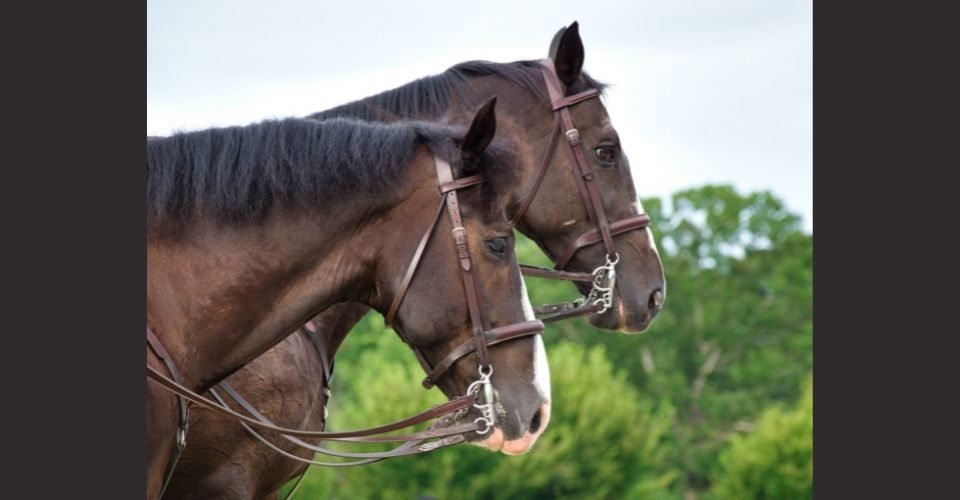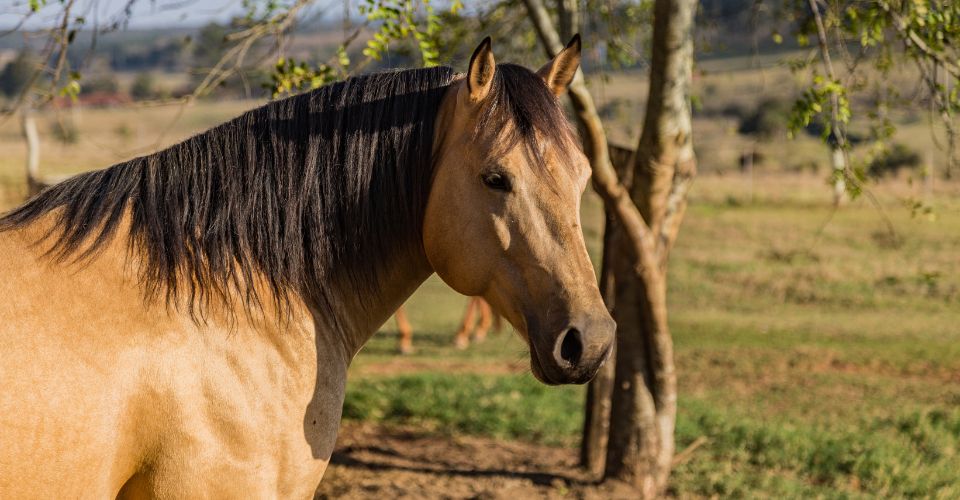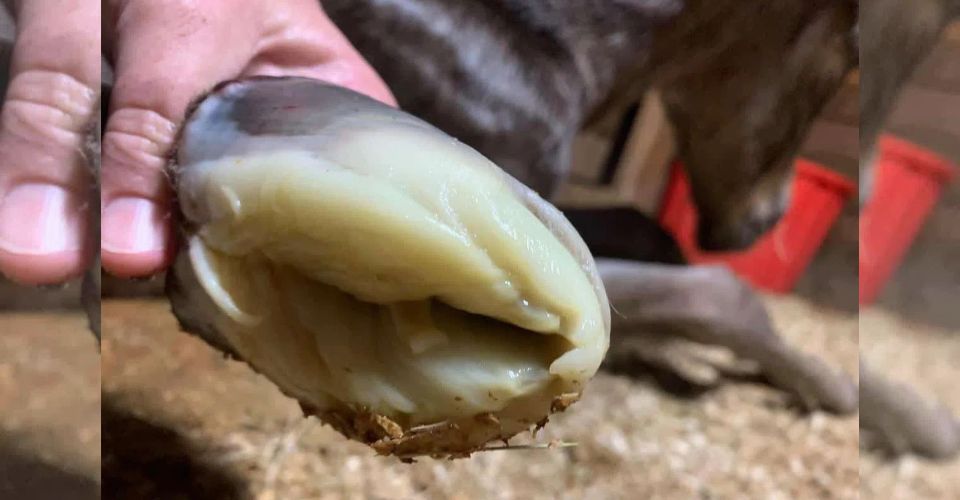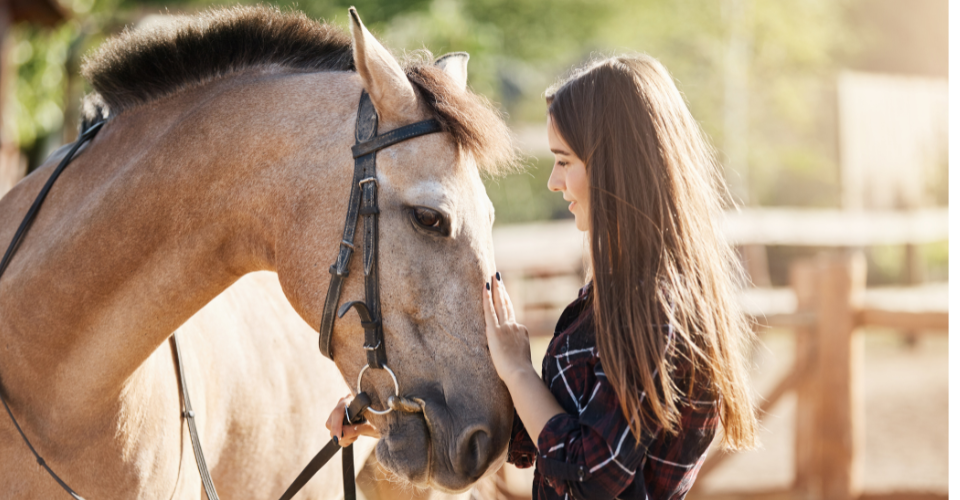There are over 350 horse breeds in the world, having different sizes, colors, and capabilities. Among them, some are large, some are medium, and others are small, and some are even smaller, like Einstein horse—the world’s smallest horse.
But what are some of the biggest horse breeds?
Let’s discuss some majestic horse breeds!
Biggest Horse Breeds
Besides being big, massive, and sturdy, they make as good partners as any other horse breed.
Below, we have compiled a list of the 15 biggest horse breeds in the world for the readers who are into them. The list is sorted in the ascending order of their height.
Continue reading to find your favorite large horse breed.
15. The Italian Heavy Draft

The Italian Heavy Draft Breed Overview
Height: 14.2 to 15.3 hands
Weight: Around 1,320 to 1,540 lbs
Lifespan: 25 to 30 years
Colors: Coat: Chestnut Tail and Mane: Flaxen, Bay, or Roan
Place of Origin: Italy
Temperament: Hardworking, energetic, friendly, easy to train
Known for strength, energy, and speed, the history of the Italian Heavy Draft horses can be traced back to the middle of the 19th century. They were produced by crossing the native Italian Po Delta horses with three different breeds: the Arabian, the Thoroughbred—one of the fastest horse breeds—and the Hackney.
During the 20th century, some more breeds were added. Their population declined due to mechanization; however, it rose again during the 1970s primarily because of the interest in meat production. Today, they are mostly bred in Italy.
They have a lighter head as compared to other draft horse breeds, and it is placed on short but broad and muscular shoulders. The legs are small with well-formed hoofs but still need shoes like other horse breeds. They have different colors, including liver chestnut. Nevertheless, their mane and tail are flax, bay, or roan.
They are matured quickly and do not need any special care. They are large but docile, smart, and fast.
Did You Know?
The Italian Heavy Draft has a long Italian name: Cavallo Agricolo Italiano da Tiro Pesante Rapido, meaning Italian Rapid Heavy Draft Farm Horse.
14. The Dutch Draft

The Dutch Draft Horse Overview
Height: 15.2 to 16 hands
Weight: Around 1,540 to 1,650 lbs
Lifespan: Around 25 years
Colors: Chestnut, Bay, Grey, and Black
Place of Origin: The Netherlands
Temperament: Calm, friendly and affectionate, and easy to train and handle
It is a relatively new breed of big horses as it was conceived no earlier than the last century. The Dutch Draft horses were bred by crossing the local mares of the Netherlands with the Ardennes and the Brabant horses. That is why they resemble the latter in appearance. Although their number declined after the First World War due to the decrease in the demand for heavy draft horses, they made a comeback with the help of breeding enthusiasts.
Today, they are popular in dressage and recreation activities apart from farm and agriculture works.
The Dutch Draft horses are heavily built and massive and walk with a precise and unhurried gait. Their common colors include chestnut, bay, and grey. They have heavily feathered lower legs as well.
They are calm and easy-going. Their personality traits include being kind, tame, and gentle as well. They are also known for their excellent stamina and thus can travel farther than most horses can travel in a day.
13. Jutland

Jutland Horse Breed Overview
Height: 15 to 16 hands
Weight: Around 1,500 to 1,800 lbs
Lifespan: 25 to 30 years
Colors: Chestnut, Black, Brown, Grey, and Roan
Place of Origin: Denmark
Temperament: Friendly, energetic, working
Jutland is a heavy draft horse breed. The breed is named after the Jutland peninsula in Denmark. Their origin can be traced back to the period of the Vikings. They later served in the medieval Danish army as well. In fact, various records suggest that they had been popular warhorses during the 12th century. The first organized breeding of Jutland draft horses started in the middle of the 19th century.
Later on, the blood from different horse breeds was also added. Their most common use is in transport; they are today associated with the Carlsberg Brewery, which transports beer across Copenhagen.
They are commonly colored in chestnut; however, other colors also exist. Their mane and tail are light-colored. They also have feathers on their legs.
They are docile, kind, and obedient. Though they are great horses, their population is on the decline.
12. The Trait Breton

The Trait Breton Horse Breed Overview
Height: 15.1 to 16 hands
Weight: Around 1,900 to 2,100 lbs
Lifespan: Around 25 years
Colors: Coat: Chestnut, and Red and Blue Roan Tail and Mane: Sand Color
Place of Origin: France
Temperament: Easy-going, friendly, and easy to train and handle
The Trait Breton horses are large but have attractive gait. The breed is believed to have originated in Brittany, France. However, there are different theories regarding the origin of Trait Breton horses. One of them states that they are about four millennia old and were brought by Aryans. During the Middle Ages, the breed was divided into the Roussin and Sommier.
Later on, the breed was crossed with different horses. Today, these horses are primarily employed in agricultural works.
These horses are strong and muscular. They have a medium-sized head, a straight or dished nose, and a short but strong neck. Their common coat colors are roan and chestnut, but their mane and tail are in sand color.
Besides being calm and friendly, they are quite adaptable. However, they are prone to the health problems like Polysaccharide Storage Myopathy (the accumulation of glycogen in muscles) and the formation of scratches that can pave the way for infections.
11. The Ardennais or Ardennes

Ardennais or Ardennes Horse Breed Overview
Height: 15.3 to 16 hands
Weight: Around 1,550 to 2,200 lbs
Lifespan: Around 30 years
Colors: Bay, Roan, Chestnut, and Palomino
Place of Origin: France, Belgium, and Luxemburg
Temperament: Gentle, affectionate, intelligent, and patient
The Ardennes is a medium-sized horse breed. The Ardennes horse is centuries old: their roots can be traced back to Ancient Rome, and they take their name after the Ardennes area in Europe. During the inception of this breed, these horses were small but grew larger in size and stamina through crossbreeding; however, the features of the Belgian breed are dominant in them. They were brought to the United States during the last century. Ardennes remained popular for their meat and strength for a long time. Today, they are famous for farm work and leisure activities.
Ardennes have big eyes and large nostrils. They have well-arched neck, and their body is overall thick and strong. Their most common coat colors include chestnut, palomino, bay, and roan. They have feather covering on and below their fetlock joints.
They are efficient at work. Moreover, they are quite gentle and docile, making them suitable for riding. Due to their hardy nature, they can easily tolerate severe winter weather. Their health issues include sidebone (ossification in feet) and Polysaccharide Storage Myopathy. They cost between the U.S. $2,500 and 5,000.
10. The Boulonnais

Boulonnais Horse Breed Overview
Other Name: White Marble Horse
Height: 14.3 to 16.3 hands
Weight: Around 1,250 to 1,650 lbs
Lifespan: Around 30 years
Colors: Grey, Chestnut, or Black
Place of Origin: France
Temperament: Energetic, docile, gentle, loving, and affectionate
They are heavy draft horses mostly used by the breeders to improve other horse breeds. The Boulonnais breed originated in France and is millennia old. They were further crossed with the Barb, the Arabian, and the Andalusian horses about 400 years ago. The Boulonnais gained popularity in France due to their charming looks. The breed arrived in the United States in the early 20th century. Their number fell drastically after the Second World War; however, it again started to increase after the 1970s.
They look quite elegant. Their head is shorter than the average size, but their forehead is broader. Their shoulders are also more inclined than the average. The most common colors are white and grey, but black and chestnut also exist.
They are always alert and quite energetic during exercise and training sessions. Furthermore, they are social and docile. However, if your Boulonnais happens to be stunning white, it may be difficult for you to keep his coat neat and clean. However, a horse grooming kit might help with the grooming process. Their common health problems include lymphedema (swelling of lower legs), Conjunctival Squamous Cell Carcinoma (cancer on the eye surface), and Polysaccharide Storage Myopathy. They usually cost between $2,000 and 10,000.
9. The American Cream Draft
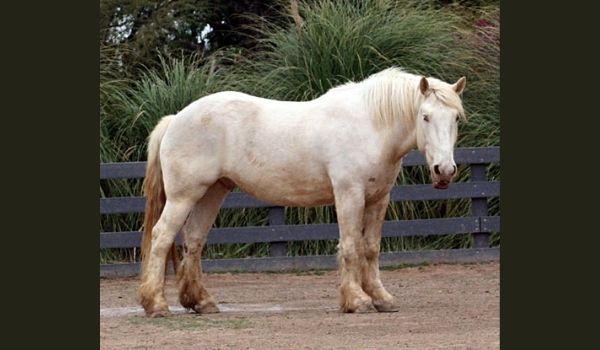
American Cream Draft Horse Breed Overview
Height: 15 to 16.3 hands
Weight: Around 1,500 to 1,800 lbs
Lifespan: 20 to 35 years
Colors: Coat: Cream Mane & Tail: White
Place of Origin: The United States
Temperament: Calm, hardworking, easy-going, friendly, and good for beginners
The American Cream Draft is a large and beautiful horse breed. These horses originated in the United States during the early 20th century. All of them can trace back their ancestry to Old Granny—a mare that was auctioned in the State of Iowa—who gave birth to a pint and cream-colored horses. Though these horses were employed in heavy works, their population started to decline due to mechanization. Nevertheless, people developed a renewed interest in them because of their looks. Resultantly, the population started growing again after the year 1982. The breed is still quite rare: there are only 500 of these horses living today.
They have a muscular body structure, and their head has a concave profile with wide eyes. The male, especially gelding American Cream Drafts, tend to be larger and heavier than their female counterparts. Color is the most eye-catching feature they possess: they have pink skin with pale cream to golden coat colors, white mane and tail, and hazel to amber eyes.
Despite their heavy stature, they have a gentle gait. They have a very calm demeanor as well. Their drawbacks include health issues like Junctional Epidermolysis Bullosa (the loss of skin) and Polysaccharide Storage Myopathy. Moreover, they can be very expensive because of their rarity.
Overall, they make a good choice for beginners.
8. The Russian Heavy Draft

The Russian Heavy Draft Horse Breed Overview
Other Name:Russian Ardennes
Height: 15.7 to 16.4 hands
Weight: Around 1,650 to 2,200 lbs
Lifespan: 25 to 31 years
Colors: Bay, Chestnut, or Strawberry Roan
Place of Origin: Russia
Temperament: Friendly, easy to train and handle, docile, loyal, and hardworking
The Russian Heavy Draft horses are well known for their traction abilities. They were bred during the 1860s in Imperial Russia and include the blood of different horse breeds, namely, the Ardennes, the Brabançon, the Percheron, and the Orlov Trotter. Their population declined after the First World War; however, their number jumped again during the 1930s. Today most of them are concentrated in the erstwhile Soviet Union region. The mares are famous for producing a good amount of milk with several health benefits associated with it.
The Russian Heavy Drafts have a strong, muscular appearance with short legs, which helps them in maintaining their traction. Based on their appearance, they are divided into three main types: Massive, Ural, and Novo Aleksandrov. They are mostly found in chestnut or strawberry roan colors.
These horses have no issue in working either on the rugged terrain or in the severe cold weather. Due to their calm nature, they make a great companion. They usually suffer from two health issues: hind end weakness (can cause pain and chronic lameness) and sickle hocks (can cause hoof wear and tear). Therefore, they must always be wearing horseshoes.
7. North American Spotted Draft
North American Spotted Draft Horse Breed Overview
Height: 15 to 17 hands
Weight: Around 1,250 to 2,000 lbs
Lifespan: 25 to 30 years
Colors: Dark base with white spots
Place of Origin: North America
Temperament: Kind, loving, affectionate, and intelligent
North American Spotted Draft horses are known for their beautiful color patterns, size, and power. Spotted Draft horses have been around for quite a long time. As a matter of fact, they served the court of Queen Elizabeth I during the 16th century. However, North American Spotted Drafts were specifically bred in the United States during the 1960s, particularly in the state of Iowa. Today, they are primarily used in shows, parades, and for pulling.
They are dense and strong. They typically have black or sorrel as base colors, with white markings all over the body. Personality-wise, they are docile, hardworking, affectionate, and intelligent. They are vulnerable to Polysaccharide Storage Myopathy, Junctional Epidermolysis Bullosa, and lymphedema. A pony can cost between the U.S. $1,500 to 5,000, while an adult can go up to $ 15,000.
6. The Suffolk Punch

Suffolk Punch Horse Breed Overview
Other Name:Suffolk Sorrel
Height: 15 to 17 hands
Weight: Around 1,600 to 2,000 lbs
Lifespan: 25 to 30 years
Colors: Different shades of chestnut color
Place of Origin: United Kingdom
Temperament: Docile, easy to train, loving, affectionate, intelligent, energetic, and powerful
The Suffolk Punch horses gained fame because of their power. The breed originated about 400 years ago and is named after Suffolk Country in England. The exact time of origin of the breed is not clear because of the lack of documentation. Initially, they were used to plow wet fields due to their might. They were mostly concentrated in Europe until they were exported to the rest of the world. They are popular in militaries; for instance, the Pakistan Army has them.
They are sturdy and have arching necks while their legs are short but strong. They are, in fact, so thickly muscled that they often appear to be shorter than they actually are. Chestnut is the only color they have. However, their mane, tail, and leg featherings are usually white.
Their personality can be summed up in three words: calm, hardworking, and energetic. Apart from these traits, they are quite resilient and tough. Their cost is around the U.S. $ 5,000, and the major health concerns include Polysaccharide Storage Myopathy and lymphedema.
5. The Australian Draught
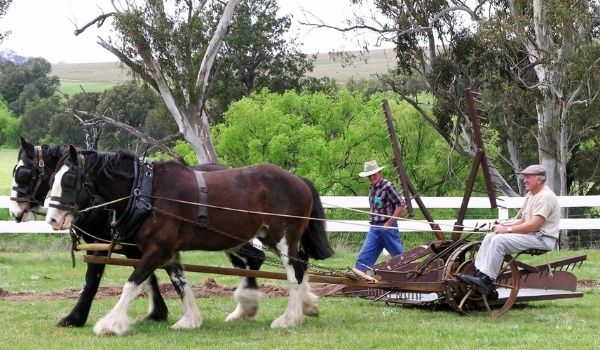
Australian Draught Horse Breed Overview
Height: 16 to 17.3 hands
Weight: Around 1,320 to 1,980 lbs
Lifespan: 30 to 40 years
Colors: Black, White, Brown, Gray, and Roan
Place of Origin: Australia
Temperament: Friendly, alert, and peaceful
The Australian Draught horses are healthy and sturdy. During the 19th century, they originated in Australia as a result of the crossbreeding of four different horse breeds – namely, the Clydesdale, the Percheron, the Suffolk Punch, and the Shire. They are, since then, being used for various purposes. They quickly became popular because they had remained the primary source of transport in Australia for a long time. They are common in agriculture, showing, pleasure riding, and competitions nowadays.
They have well-proportioned heads placed on a strong muscular body with a wide chest and back. Their legs have feather coverings. They are mostly colored in brown and black with white markings on their head.
They are resilient and hardworking, making them great working horses. Likewise, they have a friendly attitude and are not perturbed very easily, making them a good choice for beginners. As a drawback, their common health issues are Polysaccharide Storage Myopathy, Junctional Epidermolysis Bullosa, and lymphedema. You can get an Australian Draught horse for around the U.S. $ 1,500 to 10,000.
Did You Know?
In 1900, a group of Australian Draft Horses made a record of pulling 150 bales (40 thousand lbs.) of wool.
4. The Percheron

Percheron Horse Breed Overview
Height: 16 to 17 hands
Weight: 1,900 to 2,100 lbs.
Lifespan: 30 to 40 years
Colors: Black, Grey, Chestnut, Bay, Roan, or Sorrel.
Place of Origin: France
Temperament: Calm, docile, easy to handle and train
‘A gentle giant’ is the appropriate introduction for the Percheron horses. These horses are considered to have developed in and got their name from the erstwhile Perche province in France. They are the progeny of the Barb, the Flemish, and the Arabian Horses. The Percherons hit the shores of the US. in the middle of the 19th century, and their import rapidly increased by the end of the century. Currently, they are mostly seen in circuses and parades and are used for pleasure riding as well.
They have broad heads, long necks, and a well-built physique. They do not have heavy feather coverings on their legs; however, their legs are quite muscular. They are usually black and grey, with some of them having white markings on the head and feet. Because of their black coats, they are often listed as black horse breeds.
They are good for riding because they are gentle and have a lot of stamina. Furthermore, they do not have behavioral issues. Due to their calm nature and spirited attitude, they hold a distinctive place among other horse breeds. Nevertheless, their vulnerability to myopathy and lymphedema is a cause of concern. Their cost ranges between the U.S. $ 1,000 to 10,000.
3. The Belgian

Belgian Horse Breed Overview
Other Name:The Belgian Draft, The Belgian Heavy Draft, and The Brabant
Height: 16.2 to 17 hands
Weight: Around 1,800 to 2,200 lbs
Lifespan: About 18 years
Colors: Coat: Chestnut, Sorrel, Roan, and Red Mane & Tail: Light Blonde
Place of Origin: Belgium
Temperament: Docile, hardworking, friendly, easy to train, and self-aware
The Belgian Draft horse is one of the strongest among heavy horse breeds. These horses were first bred during the 17th Century in Belgium. Some clues show the Belgians descended from the Great Horses of the Medieval Period. The breed, however, in the middle of the last century, split into two: the Brabant (taller, European version) and the American Brabant (thicker, the U.S. version). Today, the latter is the most common draft horse in the U.S. They are popular in commercial carriages, pleasure riding, and show rings.
They have smaller than average heads placed on sloping shoulders. Their body is well-built and has a wide back. They have a variety of colors; however, the typical ones include chestnut and sorrel, with their mane and tail being mostly white.
Belgian horses are quite gentle and self-aware. They are hardworking as well. Such traits make them very suitable as family pets and for pleasure riding. A Belgian horse can cost from the U.S. $ 5,000 to 10,000. They are vulnerable to mud fever (softened skin due to bacterial infection), Junctional Epidermolysis Bullosa, and lymphedema.
2. The Clydesdale

Clydesdale Horse Breed Overview
Height: 16.4 to 18 hands
Weight: Around 1,500 to 2,200 lbs
Lifespan: 20 to 30 years
Colors: Black, Grey, Bay, Brown, and Roan with White spots
Place of Origin: Scotland, United Kingdom
Temperament: Lazy, calm, friendly, and easy to train
Clydesdales are tall and handsome horses. They are Scottish and originated around the valley of the Clyde River in the United Kingdom back in the 18th century. The breed is a mix of the local horses, Flemishes, and Shires. Being draft horses, Clydesdales are primarily used in different work fields. They were also conscripted for the First World War. However, nowadays, their use is somewhat limited to processions and promotions. Though the Clydesdale population started falling by the mid of the last century, it began stabilizing in 2010.
Clydesdales are sturdy and barrel-chested. Over their well-arched neck, they have a long muzzle with a slightly convex Roman nose. Their common colors include bay and brown. They have furry lower legs – believed to have evolved as protection from Scottish snow. They also have white markings on the forehead and limbs.
Clydesdales are happy horses: they are friendly, calm, and beautiful, making them great for families. Nevertheless, they are expensive to keep. Their cost falls between the U.S. $ 1,000 and 5,000 depending on the coat color and age. They are prone to lymphedema, Polysaccharide Storage Myopathy, and different skin infections.
1. The Shire

Shire Horse Breed Overview
Height: 16 to 18 hands
Weight: Around 1,875 to 2,400 lbs
Lifespan: 20 to 45 years
Colors: Black, Grey, Bay, Brown, Roan, and Chestnut
Place of Origin: England, United Kingdom
Main Personality & Temperament Traits: Docile: Easy to handle and train.Hardworking: Good at exercise and training. Patient: Not easily scared
The Shire Breed is currently regarded as the tallest and the heaviest horse in the world. They are also regarded as one of the most famous draft horse breeds. Descendants of the Great English Horses, Shire horses originated during the 19th century in the United Kingdom. Since then, owing to their size, muscular physique, and power, they have been widely used to work in agricultural fields and play different roles in wars. In fact, they are one of the popular medieval war horse breeds and were extensively used in King Henry VIII cavalry. Nevertheless, rapid industrialization has almost stripped them of such uses. Moreover, their population is also declining.
Largest Horse in the World!
Shire gelding Sampson holds the record of being the largest and heaviest horse. He stood at 21.25 hands and 3,360 lbs, according to the Guinness world record.
Shires are long with elongated necks and sloping shoulders. White feathers cover their lower legs, and they also have white spots on their face. The most common coat colors include black, grey, and brown. Regarding speed, they can run at 30 to 35 mph.
They are quite docile, eager to please, and have a mature attitude, which makes them suitable for horse-lovers with any experience level. However, due to their imposing size, they need more than the average quantity of food. Depending on his age, you can expect to pay between $200 to 20,000 for a Shire horse. They are prone to lymphedema and Polysaccharide Storage Myopathy.

